Conversation with Stuart Netsky
by Elizabeth Johnson, edited by Matthew Crain
Conversation with Stuart Netsky
by Elizabeth Johnson, edited by Matthew Crain

Venus Disarming Cupid, (After Boucher And Twombly), 2022, 13" x 19", Digitally Produced Print, Edition 1 of 5
Elizabeth Johnson: Your prints in your current show join radically different images to express the visual overkill of contemporary culture, but it seems that you aren’t entirely critical of the excess, since you revel in it. Do you enjoy scrolling though social media or jumping between cinematic decades via streaming? How does the seam between images function for you? Does it indicate a jump in thought and/or time and function to compress a group of dramatic moments into a whole? Are you aiming to compare several unrelated high points of Western culture? or to express the vastness of cultural experience?
Stuart Netsky: I do revel in excess to express the visual overkill. Though I don’t enjoy scrolling through social media, I do enjoy jumping between cinematic decades via streaming. This does indicate a jump in thought and time that, as you suggest, functions to compress a group of dramatic events into a whole. I do aim to compare several high and low points of Western culture, through splicing. The splicing allows me to juxtapose images, whether art historical, flowers or patterns from biology and science, and acts in a cinematic way, akin to the splicing that occurs in film editing.
EJ: Your super-hot colors and juxtapositions fit with your love of Rococo, celebrating youth and progress against the backdrop of art history...
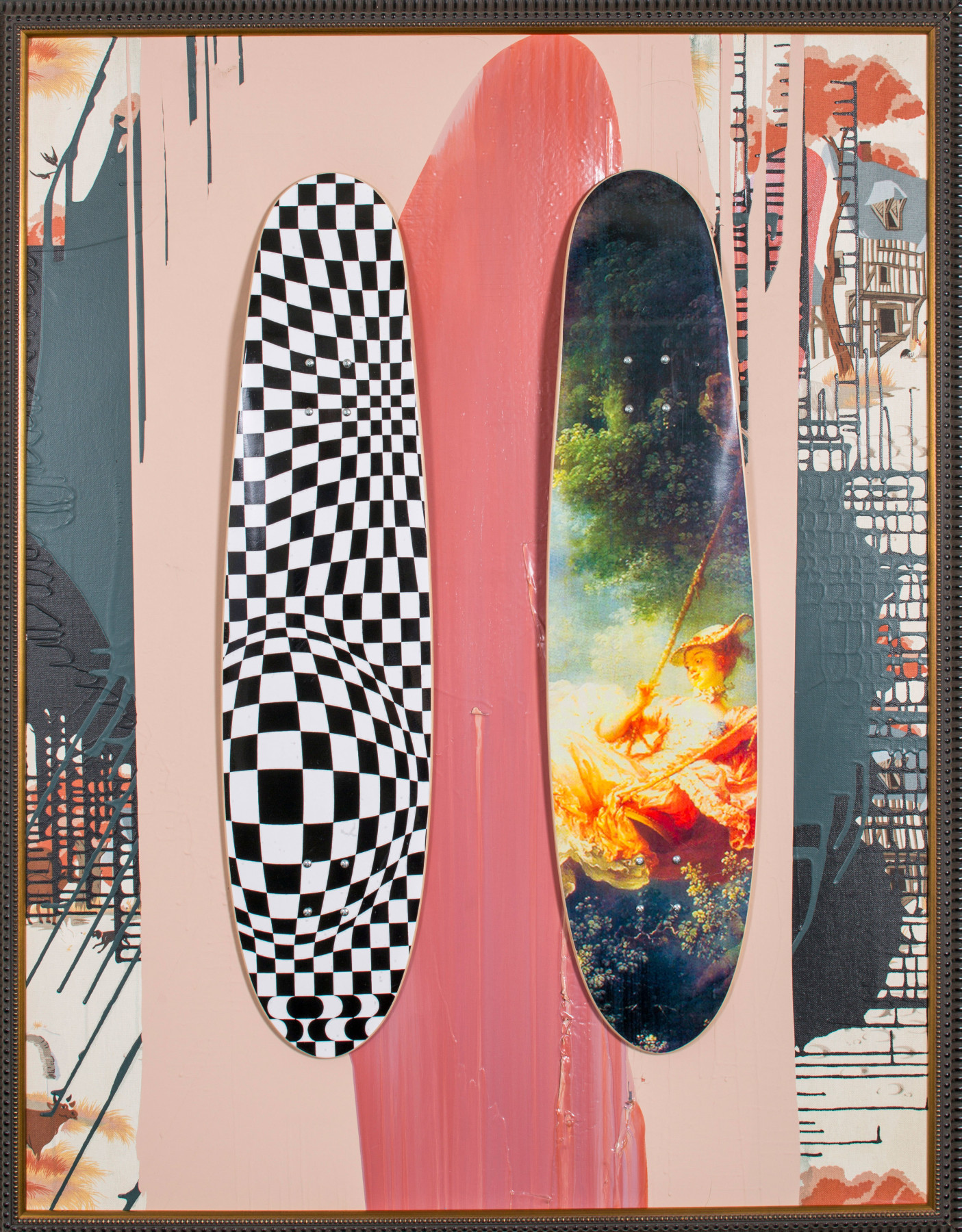
Why Do Artists Make Skate Decks?, 2015, 54.5" x 43.5" x 2", Mixed Media
EJ: ...How did you get interested in skate culture? Did you design the decks for Why Do Artists Make Skate Decks?? Did making the piece answer your question? The question as title freezes the query in time and keeps the piece fresh.
SN: Skate culture intrigues me. Probably because I never engaged in sports and skate culture is all encompassing. I envy the skateboarders brazen risk-taking ability to perform and I appreciate the sport and its style, fashion, and marketing. But I really don’t understand artists making skate decks. It’s truly a mystery to me how the two came together. Where I’ve appropriated art historical images, I embrace the absurdity of the “artist-designed skate deck,” integrating images into works wherein the absurdity is enhanced and yet it contradicts the surrounding imagery.
EJ: Your bio on the Gross McCleaf website mentions that from 1977 through 1983 you ran your own millinery design company in New York City. You have a Bachelor of Science in Design and Merchandising from Drexel University (’83), and since 1984 you’ve been a professional artist. What made the change? Was it a gradual buildup? What did you learn in millinery design or merchandising that you still use today?

Spring, (After Boucher), 2022, 17" x 22", Digitally Produced Print, Edition 1 of 5

Millenary Design by Stuart Netsky
SN: I always felt I was an artist. As a child I studied at the PMA as well as attended summer sessions at Moore College of Art. I was an art major in high school and intended to pursue art in college. But my parents had a different idea. They insisted I pursue a more “stable” career path. My family was in the garment trade, so I chose to pursue fashion design at Pratt Institute. That lasted one semester. I came home to Philadelphia and enrolled at Drexel University to study Design and Merchandising. In my junior year, I began designing women’s hats. Through a series of circumstances, a business ensued, and the company and I moved to NYC. As a hat designer, I felt like I was making sculpture, and I approached millinery design as such, making quite eccentric objects for women to wear on their heads. After a few years the business came to an end, and I inevitably ended up at Tyler School of Art working toward an MFA in Sculpture. I truly believe what one is meant to be or pursue comes to fruition.
EJ: The Gross McCleaf statement mentions that you mix “François Boucher and Gerhard Richter, Jean-Honoré Fragonard, Gene Davis, Bridget Riley, Nicholas Krushenick and Jean-Antoine Watteau. . ..” How do you choose artists from our current age? For instance, were Krushenick and Davis, who are less well known than Riley or Richter, people you know? Do you enjoy leveling the playing field and ignoring barriers between levels of success?
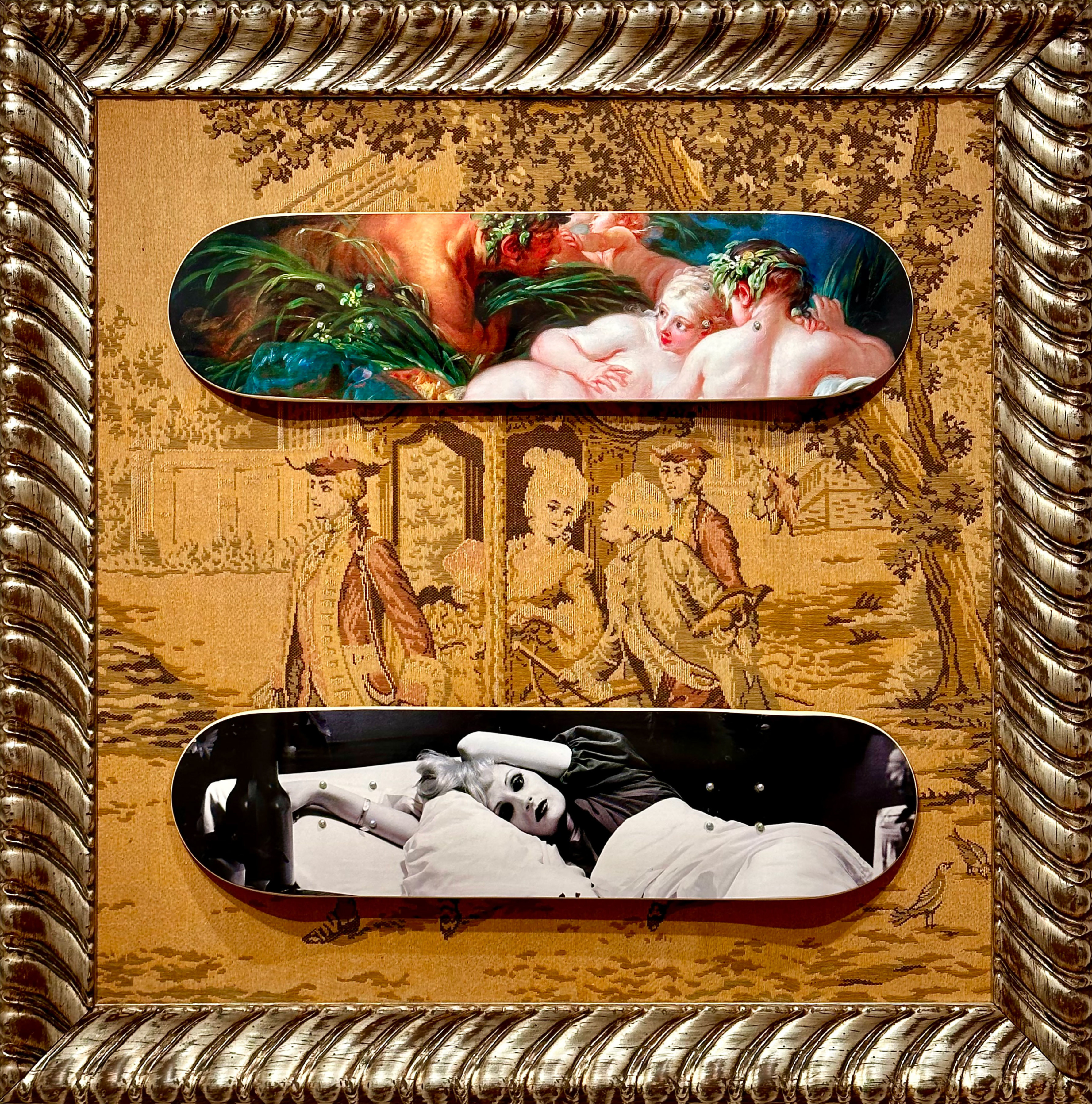
Candy Go Lightly, 2015, 38" x 38", Mixed Media
SN
SN: I make no distinction between levels of success. I don’t think about it. The works of Nicholas Krushenick and Gene Davis have been with me since my adolescence when my high school art teacher turned me on to them. I was painting then, and committed myself to hard edge abstraction, in the manner of Krushenick and Davis.
EJ: On your website there is a sculpture titled, “That we find a crystal beautiful means that we are less alone, that we are more deeply inserted into existence than the course of a single life would lead us to believe. John Berger.” Your spliced prints feel crystalline, and almost random in the way that they break up experience. Using fractal and microscopic images brings in aloofness and the deep time of science. Are the microscopic images folded proteins? Does interspersing images of Rococo and Romantic love with those of biology, DNA, or evolution seek to take the bigger biological view of sexual attraction?
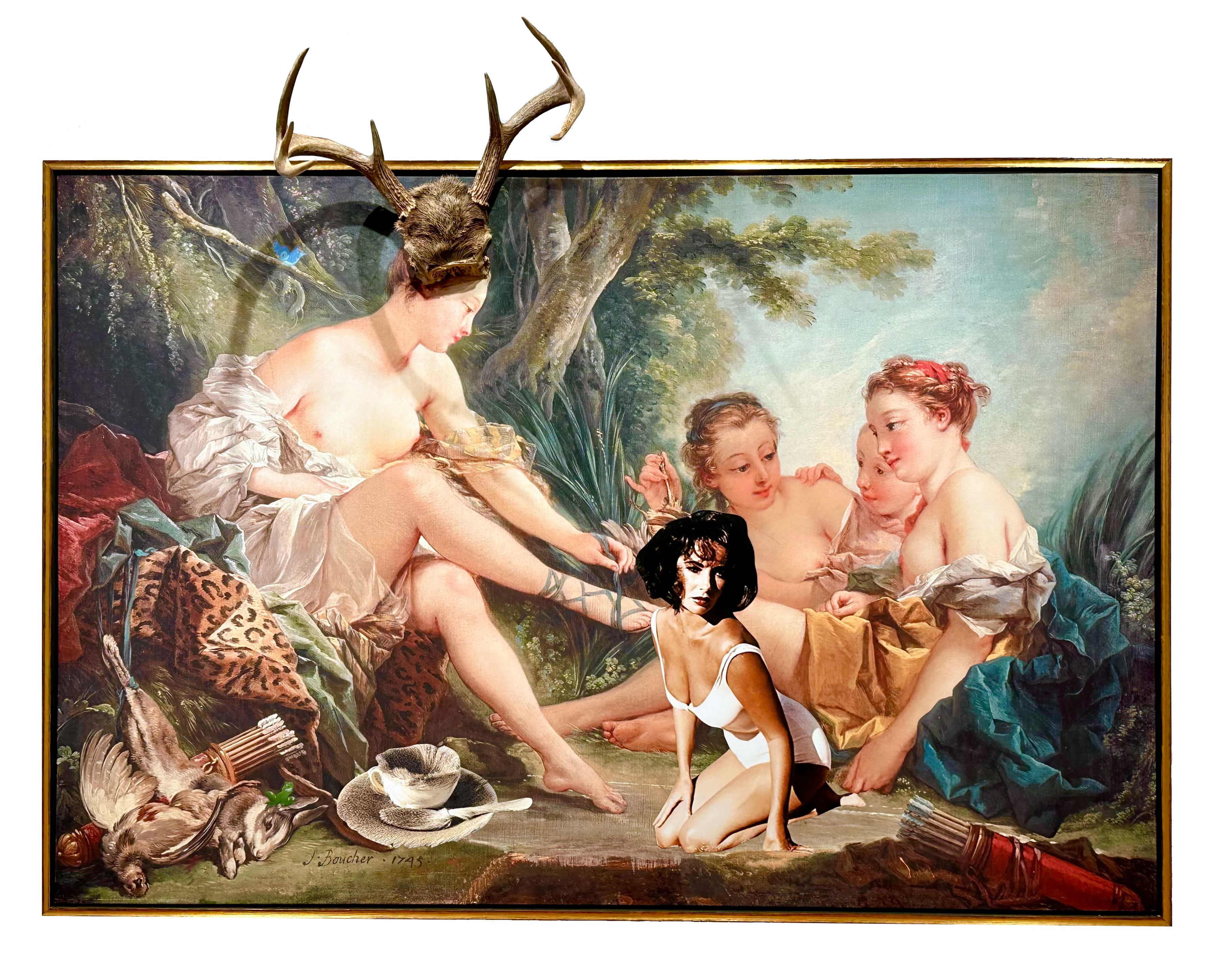
Diana And Liz After The Hunt, 2016-2023, 40" x 60", Mixed Media
SN: The microscopic images are of diseases: anthrax, AIDS, heart disease and bacterial infections. I researched the images of these diseases as they are found under the microscope and found them to be beautiful. I like the idea that something deadly can be beautiful and appear innocent. By splicing them into the compositions and sometimes altering the color, I render them decorative, à la Boucher.
EJ: Regarding Diana And Liz After The Hunt: are you treating hunting recursively since Diana would be both the hunter and hunted? How did you attach the antlers to the surface of the painting? Is this piece a pun on hunting for love?
SN: I love women. I love strong women. The impetus to attach the antlers to Diana in the painting was to embrace her strength and power and celebrate her as victorious. The antlers are attached with nuts and bolts to the back of the canvas. I do not interpret this piece as a pun on hunting for love, though the idea interests me.
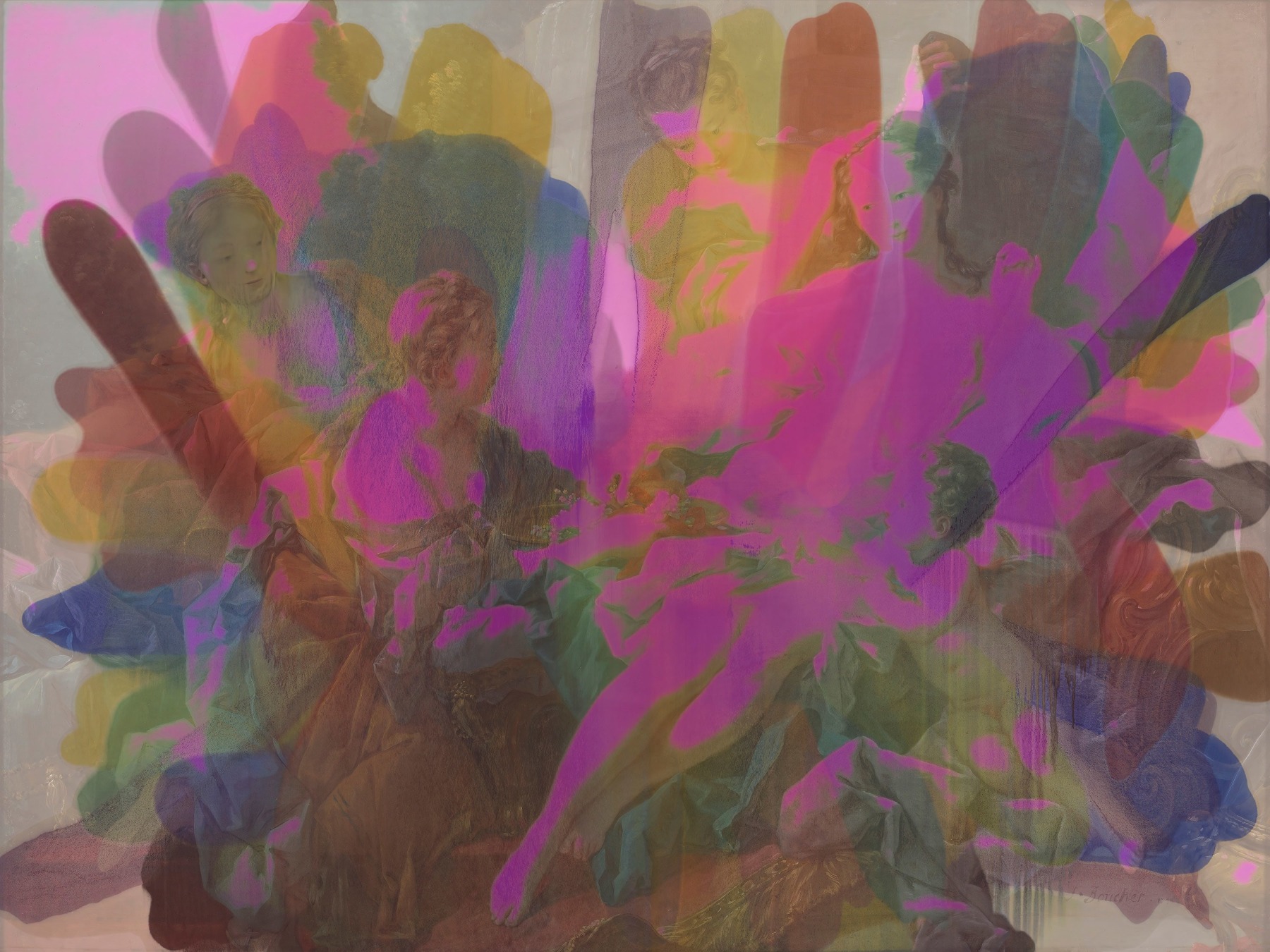
The Toilette Of Venus, (After Boucher And Morris Louis), 2022, 13" x 19", Digitally Produced Print, Edition 1 of 5
EJ: The Toilette Of Venus (After Boucher And Morris Louis) and The Rape Of Europa, (After Boucher And Vasarely) layer images more softly than your splices. Do you think of the two composition styles as emoting differently? Or are they very similar to you since your goal is to create a sense of everything happening all at once?
SN: Those pieces you mention and Venus Disarming Cupid (after Boucher and Twombly) are three of the most recent of the prints. And as you accurately observed, the images are layered rather than spliced. I feel they do emote differently. These three achieve a greater sense of abstraction, and the one after Twombly almost achieves that of a color-field. This interests me greatly and is the direction I am going with new prints. I do agree that regardless of the style, there is the sense that everything happens at once.

The Rape Of Europa, (After Boucher And Vasarely), 2022, 13" x 19", Digitally Produced Print, Edition 1 of 5
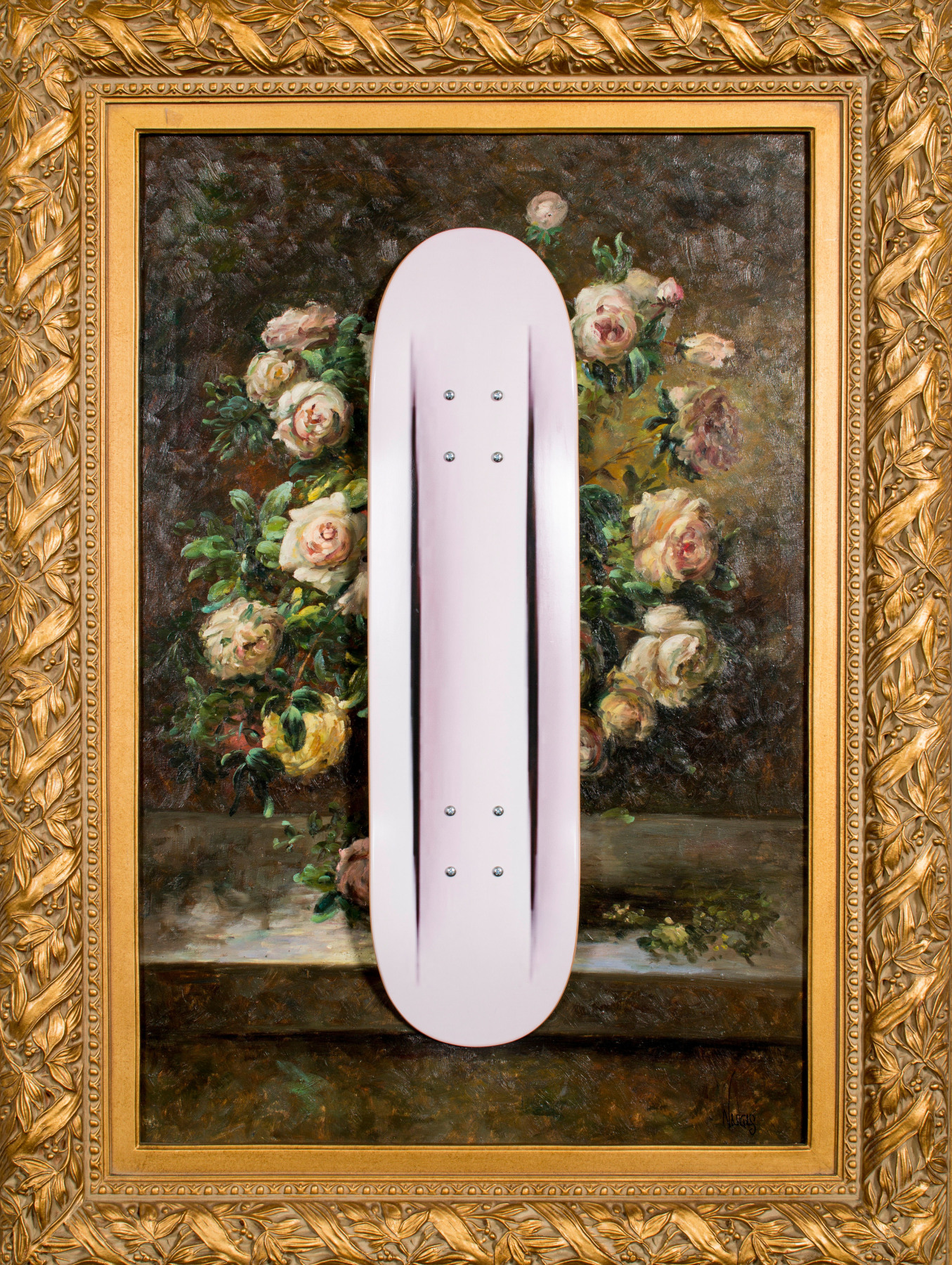
Untitled, (After Fontana), 2015, 45" x 43.5" x 2", Mixed Media
EJ: I love how Untitled, (After Fontana) generates a pleasing formality. Fontana-like cuts intersect with attaching bolts and a flower painting very mysteriously. Who did the flower painting? Do you prefer it if the different elements in the prints add up to a new aesthetic? Or do you prefer them to remain disjointed?
SN: The flower painting came from a flea market. I like it that the different elements remain disjointed and that the intersection of these disparate elements is mysterious.
EJ: Do you relate to Jeff Koons’s work and/or his embrace of commerce? When I see Bubbles and Made in Heaven now, I recall the ’90s more than I get new readings of the pieces themselves, I feel intense nostalgia for those years. What is your take on him? Do your successive series encapsulate the moments they are made?
SN: Generating nostalgia for the present and the future is important to me. I feel nostalgia when I appropriate the works of Boucher and other artists. I have a strong connection to the romanticism and beauty in the Boucher works. I recall the ‘90s and feel nostalgia for the period. I remember seeing the works of Jeff Koons, the Bubbles show, the Made in Heaven billboards, the shows of David Salle, Haim Steinbach, and Ashley Bickerton. Their works, though not in the forefront of my mind, they are with me and are present in my art.
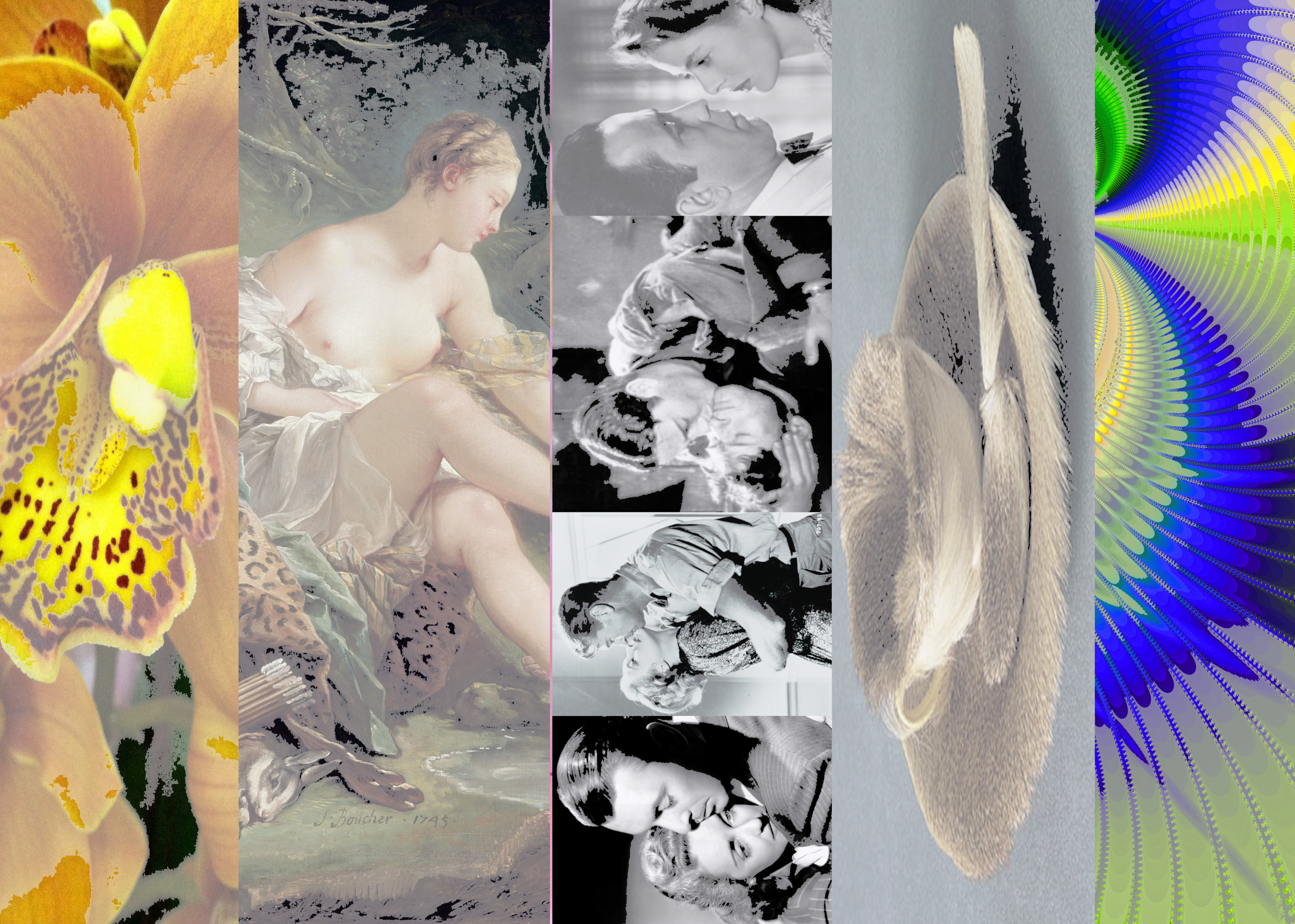
Diana After the Hunt/The Kiss, (After Boucher), 17" x 22", Digitally Produced Print
SN: Nostalgia for what are considered “women’s films” of the 1930s and ’40s appears in Diana After the Hunt/The Kiss, (After Boucher). A vertical splice of famous film kisses fills the center of the composition. The kisses referenced are Bette Davis and George Brent from Dark Victory, Patricia Neal and Gary Cooper from The Fountainhead, the two male characters from the 1927 film Wings (considered the first male kiss in cinema), and Ingrid Bergman and Humphrey Bogart from Casablanca. Though I was not aware of Wings as a child, the other films had a heady influence on me with their passionate romantic sequences. I identified with the women. As a young boy who didn’t yet understand he would become gay, I was being tormented at school for my effeminate behavior and dislike of sports. I would come home from school and retreat into these films and fantasize that a love like that which I was watching, really could exist.
SN: I still do it! I juxtapose the splice of film kisses next to Méret Oppenheim’s The Luncheon in Fur, which is thought to be the quintessential Surrealist object, perhaps a lesbian Surrealist object. Its placement in the composition of Diana is as much a reference to Diana the Huntress as the screen kisses.

EJ: Does being gay drive your aesthetic in your current body of work?
SN: There is a camp sensibility at work in my practice. I’ve described the work as manifesting a drag display of sorts in the way intense color and pattern play in the compositions. Boucher’s cupids frolic in gay abandon as deadly viruses form a forest of colorful deceit.
I appropriated Fragonard’s Girl on a Swing for Have Your Cake And Eat it Too. A reproduction of his painting has an ornate cake glued over the girl’s skirt. In Untitled, a part of the same image is reproduced on a skate deck. I chose Girl on a Swing for its sexual symbolism. If you trace a line from the man courting the girl on the swing to the girl’s open skirt, you will find that a straight line leads from his head straight to her vagina. One can interpret the man as a phallus, and the girl as a provocative seductress. I love this. This reading can be gleaned from other works of Boucher. It is one of the reasons I chose to appropriate Fragonard and Boucher. The hedonistic celebrations in some of Boucher’s paintings are akin to an orgy. This interpretation falls within the context of camp. “Camping it up” has historically been a way of surviving adversity whether it be discrimination or AIDS, and though it’s difficult to have fun in the face of this kind of suffering, some gay men have found strength through the brotherhood of camp. Excess, exaggeration, and artifice define the camp aesthetic. My work illustrates this aesthetic, and in doing so, I come out.
––Elizabeth Johnson
(elizabethjohnsonart.com)
edited by Matthew Crain
(@sarcastapics)
March 2023